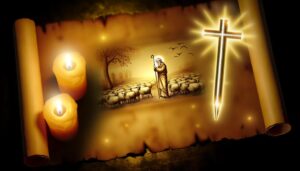Archer Meaning In The Bible: Symbol of Warfare
In biblical texts, archers play significant roles, both literal and metaphorical. They were essential in ancient warfare, offering precision and strategic advantage, as seen when Jehu killed King Joram (2 Kings 9:24).
Symbolically, arrows often signify divine judgment and the penetrating nature of God’s word, evident in Psalm 7:13. Prophetic writings use archery imagery to underscore inescapable judgment and God’s unwavering protection (2 Kings 13:17).
This metaphor extends to spiritual lessons, where mastery in archery mirrors discipline in faith. Foundational themes of divine justice, protection, and spiritual growth are illuminated through the archery metaphor.
For further exploration, consider the multifaceted roles and deeper theological implications.
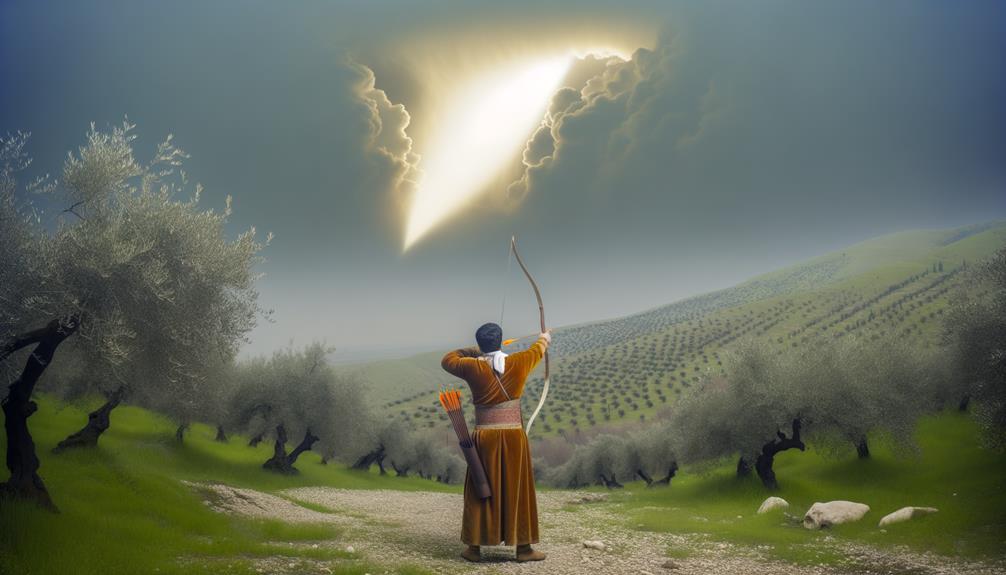
Archer Meaning in the Bible: Symbolism and Spiritual Significance
| Aspect | Explanation |
|---|---|
| Biblical Reference | Mentioned in Genesis 21:20, referring to Ishmael as a skilled archer |
| Symbolism | Strength, focus, and divine skill |
| Spiritual Meaning | Represents spiritual warfare, aiming with purpose, and God’s empowerment |
| Moral Insight | Encourages spiritual discipline and trust in divine direction |
| Faith Message | A call to aim your life with faith and rely on God’s guidance |
Archers in Biblical Warfare
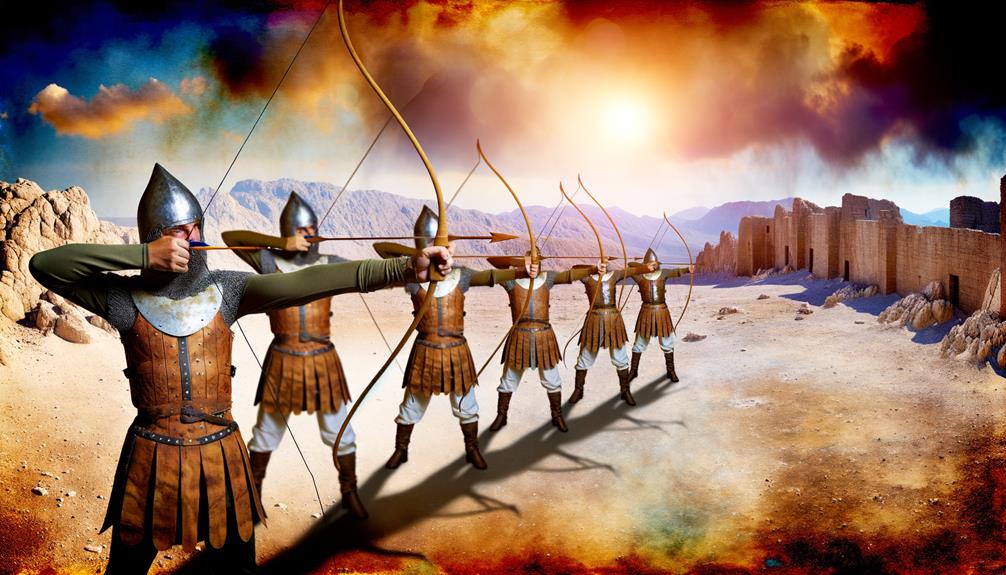
Throughout biblical history, archers played a critical role in the dynamics of warfare, serving as both offensive and defensive units in numerous battles documented in the scriptures. Their strategic importance is highlighted in various passages, such as in 1 Samuel 31:3, where archers critically wounded King Saul.
The precision and range of archers provided tactical advantages, allowing armies to engage enemies from a distance, thereby altering battle outcomes. In 2 Kings 9:24, Jehu’s use of archery to strike down King Joram exemplifies the lethal efficacy of the bow.
Additionally, Psalms and prophetic writings often reference archers, illustrating their significance in both historical and metaphorical contexts. Archers, therefore, were indispensable assets in the military frameworks of ancient Israel.
Symbolism of Arrows

Arrows in biblical literature often serve as potent symbols, representing themes of divine judgment, deliverance, and the piercing nature of God’s word.
In the Psalms, arrows are frequently depicted as instruments of God’s righteous anger (Psalm 7:13). Conversely, they also symbolize deliverance, as in the narrative of Elisha instructing Joash to shoot arrows symbolizing victory over Syria (2 Kings 13:17).
Additionally, arrows metaphorically illustrate the penetrating power of God’s word, as seen in Hebrews 4:12, where the word of God is described as ‘sharper than any double-edged sword.’
This multifaceted symbolism underscores the arrow’s role as a divine instrument, wielded by God to accomplish His purposes, whether in judgment, salvation, or revelation.
Divine Judgment Imagery

Biblical texts frequently employ vivid imagery of divine judgment, utilizing metaphors and symbols to convey the severity and righteousness of God’s retributive actions. One prominent metaphor is that of God as an archer, whose arrows symbolize impending judgment upon the wicked.
This imagery serves several purposes:
- Precision: The archer’s skill reflects the accuracy of divine judgment.
- Inescapability: Just as an arrow swiftly reaches its target, divine retribution is unavoidable.
These symbols underscore the theological premise that divine judgment is both just and inevitable, reinforcing the omnipotence and moral authority of God.
The archer metaphor consequently powerfully conveys the gravity of divine retribution in biblical literature.
Protection and Deliverance
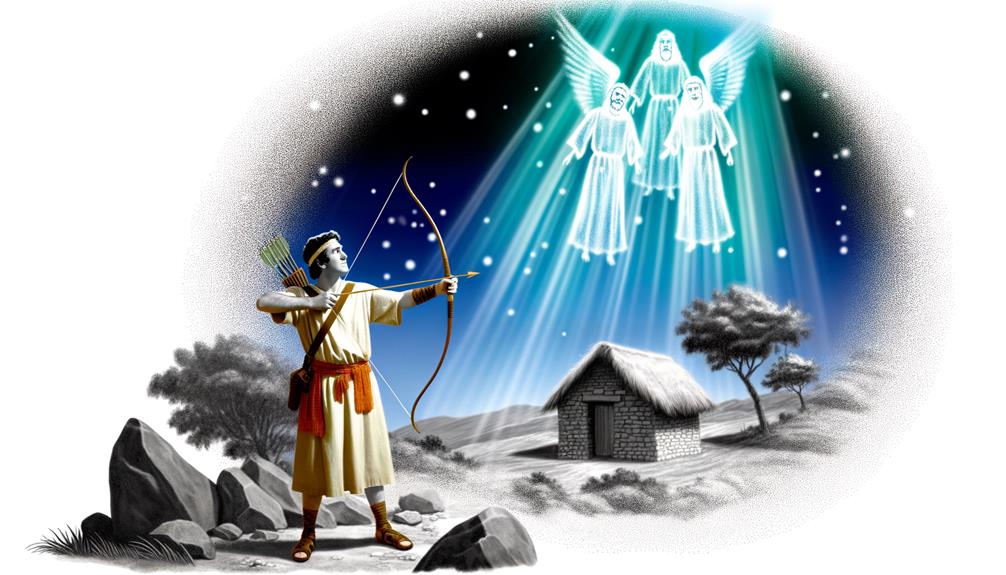
In examining the theme of Protection and Deliverance within the biblical context, one must consider the role of divine guardianship as illustrated through the symbolism of arrows.
These arrows often represent God’s intervention and safeguarding of His people, as seen in various biblical rescue narratives.
Divine Guardianship Explained
Understanding divine guardianship within biblical texts necessitates an exploration of the multifaceted ways in which protection and deliverance are depicted through the metaphor of the archer. The archer, as a symbol of divine guardianship, offers a vivid portrayal of God’s active role in safeguarding His people. This imagery is powerful and can be seen in various scriptural contexts:
- Psalm 91:4 – God is likened to a protector, shielding with His wings.
- 2 Samuel 22:31 – God’s way is perfect, serving as a shield for all who take refuge in Him.
Such depictions underscore the theological premise that divine guardianship is both a protective and a deliverance-oriented force.
Symbolism of Arrows
The metaphor of arrows within biblical narratives further elucidates the themes of protection and deliverance, reinforcing the concept of divine guardianship.
Arrows, often depicted as instruments of both defense and judgment, signify God’s intervention in the lives of His people. The Psalms frequently employ this imagery, portraying God as an archer whose arrows protect the righteous and thwart the wicked (Psalm 7:13).
Additionally, arrows symbolize the swiftness and precision of divine action, underscoring God’s omnipotent care. In the context of deliverance, arrows represent the means by which God rescues His faithful, ensuring their safety amidst adversities.
This duality encapsulates the protective and redemptive dimensions of God’s relationship with humanity, offering profound theological insights into His unwavering guardianship.
Biblical Rescue Stories
Biblical rescue stories vividly illustrate the themes of divine protection and deliverance, showcasing God’s unwavering commitment to His people. Through these narratives, we see God’s direct intervention in moments of peril, affirming His role as a protector and savior. These stories are not just historical accounts but theological affirmations of God’s power and mercy.
- The Exodus: God delivers the Israelites from Egyptian bondage, parting the Red Sea to guarantee their escape.
- Daniel in the Lion’s Den: God protects Daniel from harm, exemplifying divine deliverance amid persecution.
These accounts underscore the biblical message that divine rescue is both a historical reality and a continual promise.
Archers in Prophetic Visions

In prophetic visions, archers often symbolize divine judgment and impending conflict, representing the precision and inevitability of God’s will.
This imagery not only underscores the certainty of judgment but also provides a framework for understanding future fulfillments predicted in the scriptures.
Symbolism in Prophecies
Within the domain of biblical prophecy, archers often serve as potent symbols of divine judgment and impending conflict. These figures, wielding their bows, are evocative of impending trials and the manifestation of God’s will.
Prophetic texts frequently employ the imagery of archers to convey multifaceted messages:
- The sight of archers preparing their bows symbolizes the advent of war and strife.
- Arrows flying through the air often represent the swift execution of divine decrees.
This use of archers in prophetic visions underscores the seriousness of God’s judgments and the inevitable consequences of defying divine mandates, enhancing the scriptural narrative’s depth and urgency.
Divine Judgment Imagery
The prophetic utilization of archers as emblems of divine judgment vividly illustrates the severity and inescapability of God’s decrees.
Scriptural passages, such as Jeremiah 50:29, employ archers to symbolize the precision and inevitability of divine retribution. The imagery of arrows suggests a targeted, deliberate action, reinforcing the concept that divine justice is not arbitrary but meticulously administered.
Additionally, Psalm 7:12-13 depicts God preparing His bow and arrows, underscoring the readiness and swiftness of divine judgment upon unrepentant sinners. This symbolism serves a dual function: it warns of impending judgment while affirming God’s sovereignty and moral order.
Such metaphorical language in prophetic visions provides a profound theological insight into the nature of divine justice within the biblical narrative.
Future Fulfillment Context
Prophetic visions frequently employ the archer motif to depict the anticipated fulfillment of divine promises and judgments in eschatological contexts. This imagery is profoundly symbolic, suggesting a range of theological interpretations:
- Divine Retribution: The archer’s arrow can signify God’s impending judgment, as seen in prophetic books where arrows are metaphorically used to describe divine wrath.
- Deliverance and Salvation: Conversely, the archer can represent the arrival of messianic deliverance, with arrows symbolizing the swift and precise fulfillment of God’s promises.
- Cosmic Warfare: The archer also figures in apocalyptic literature to illustrate the ultimate battle between good and evil, where divine forces wield arrows to vanquish adversarial powers.
These depictions underscore the complex roles archers play in the unfolding of divine plans.
Metaphors for Human Struggles

Biblical references to archery often serve as poignant metaphors for human struggles, highlighting the tension between divine providence and individual effort.
For instance, the Psalmist’s invocation in Psalm 127:4-5 likens children to arrows in a warrior’s hand, symbolizing human potential guided by divine wisdom.
Similarly, in Isaiah 49:2, the servant of the Lord is depicted as a polished arrow, emphasizing the refinement and direction provided by God.
These metaphors elucidate the dual nature of human endeavor: while individual effort is essential, ultimate success is seen as reliant upon divine guidance and grace.
Consequently, archery in biblical texts becomes a rich symbol of the interplay between human agency and the overarching sovereignty of God.
Notable Biblical Archers
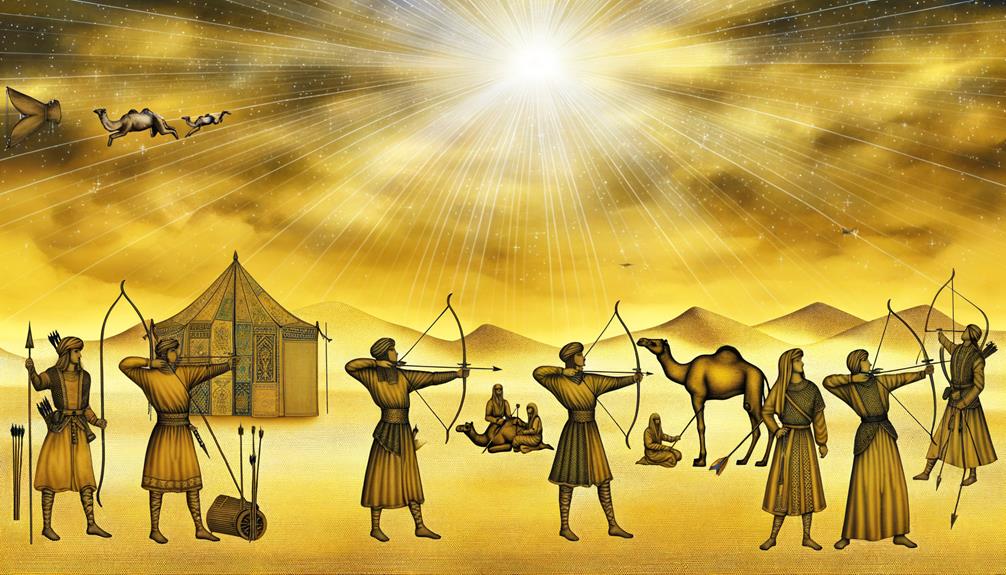
Among the notable archers mentioned in biblical narratives, the figure of Ishmael stands out, symbolizing both human resilience and the fulfillment of divine promises. Ishmael, the son of Abraham and Hagar, is portrayed as an adept archer in Genesis 21:20, reflecting his survival and growth in the wilderness. His proficiency with the bow underscores God’s providential care, even in exile.
Similarly, other biblical characters exemplify archery’s prominence:
- Esau: Known for his skill in hunting, representing primal strength.
- Jonathan: The loyal friend of David, exhibiting fidelity and martial prowess.
These archers enrich the biblical narrative, illustrating themes of survival, loyalty, and divine intervention.
Spiritual Lessons and Insights

The prominence of archers in biblical narratives not only highlights historical and cultural elements but also serves as a conduit for profound spiritual lessons and theological insights. Archery, emblematic of precision and focus, mirrors the spiritual discipline required in faith. Just as an archer aims for the target, believers are called to aim for righteousness.
| Archer’s Skill | Spiritual Parallel |
|---|---|
| Focus on the Target | Fixing Eyes on Jesus |
| Steady Hand | Steadfast Faith |
| Patience | Waiting on God’s Timing |
| Mastery through Practice | Spiritual Growth through Discipline |
The meticulous nature of archery underscores the importance of intentionality in spiritual life, reminding believers to thoughtfully direct their efforts towards divine goals.
Conclusion
The imagery of archers and arrows in the Bible weaves a rich tapestry of warfare, divine judgment, and spiritual struggle, painting vivid scenes of conflict and protection. These themes are further enhanced by the battle axe symbolism in scripture, representing God’s power to cut through adversity and sin. The sharpness of the axe serves as a metaphor for divine intervention, illustrating how faith can pierce through the darkness of despair. Together, these images inspire believers to trust in divine strength during their own personal battles.
Symbolic of God’s judgment and human frailty, the archer’s bow becomes an instrument of both destruction and deliverance.
By examining notable biblical archers and prophetic visions, profound spiritual lessons emerge, offering insight into the complex interplay between divine sovereignty and human agency in the sacred narrative.

